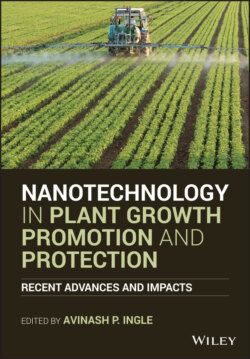Читать книгу Nanotechnology in Plant Growth Promotion and Protection - Группа авторов - Страница 26
1.3.2 Nanobactericides
ОглавлениеMetal nanoparticles such as silver (Ag), copper (Cu), zinc oxide (ZnO), and titanium dioxide (TiO2) have been studied for their antibacterial activities (Kah and Hofmann 2014). Nano TiO2 either alone or with zinc or silver was used against Xanthomonas sp., the causal agent of bacterial spot disease in roses (Paret et al. 2013a) and tomatoes (Paret et al. 2013b). Field (Paret et al. 2013a) and greenhouse (Paret et al. 2013b) studies showed that the severity of bacterial spot disease in rose plants was significantly reduced – in case of plants treated with TiO2/Zn as compared to untreated control plants. Furthermore, TiO2 nanoparticles present in nanofertilizers reported to provide protection from bacteria (Sadeghi et al. 2017). In an in vitro study performed by Mondal and Mani (2012), it was observed that copper nanoformulation could reduce the growth of bacterial blight on pomegranate at 0.2 mg/L, a concentration which is much lower than the recommended dose of copper oxychloride (2500–3000 mg/L).
